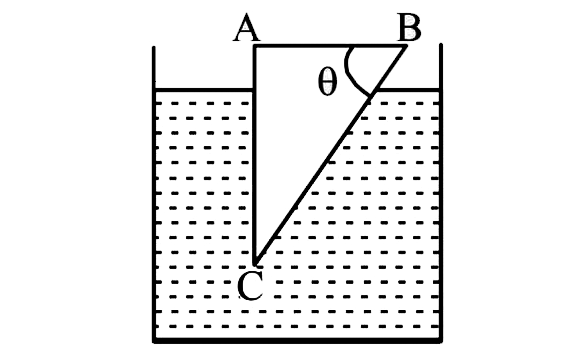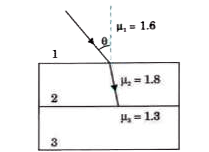OBJECTIVE TYPE QUESTIONS (JEE (MAIN) & OTHER STATE BOARDS FOR ENGINEERING ENTRANCE) from MODERN PUBLISHERS PHYSICS Chapter 104 RAY OPTICS AND OPTICAL INSTRUMENTS for Class 12
| Class 12 | PHYSICS |
| Chapter | RAY OPTICS AND OPTICAL INSTRUMENTS |
| MODERN PUBLISHERS PHYSICS | OBJECTIVE TYPE QUESTIONS (JEE (MAIN) & OTHER STATE BOARDS FOR ENGINEERING ENTRANCE) |
| Medium | English |
| Academic Year | 2023-2024 |
Question 1
A beaker contains water up to a height h1 and kerosene of height h2 above water so that the total height of (water + kerosene) is (h1+h2) . Refractive index of water is μ1 and that of kerosene is μ2 . The apparent shift in the position of the bottom of the beaker when viewed from above is :-View SolutionQuestion 2
A convex lens (of focal length 20 cm) and a concave mirror, having their principal axes along the same lines, are kept 80 cm apart from each other. The concave mirror is to the right of the convex lens. When an object is kept at a distance of 30 cm to the left of the convex lens, its image remains at the same position even if the concave mirror is removed. The maximum distance of the object for which this concave mirror, by itself would produce a virtual image would be : View SolutionQuestion 4
A planoconvex len becomes an optical system of 28 cm focal length when its plane surface is silvered illuminated from left to right as shown in Fig-A.
It the same lens is instead silvered on the curved surface and illuminated from other side as in Fig.B, it acts like an optical system of focal length 10 cm. The refractive index of the material of lens is :
 View Solution
View SolutionQuestion 6
Let the x-z plane be the boundary between two transparent media. Medium 1 in z≥0 has a refractive index of √2 and medium 2 with z<0 has a refractive index of √3. A ray of light in medium 1 given by the vector →A=6√3ˆi+8√3ˆj−10ˆk is incident on the plane of separation. The angle of refraction in medium 2 is:View SolutionQuestion 7
An object 2.4 m in front of a lens forms a sharp image on a film 12 cm behind the lens. A glass plate 1 cm thick, of refractive index 1.50 is interposed between lens and film with its plane faces parallel to film. At what distance (from lens) should object shifted to be in sharp focus of film?View SolutionQuestion 19
To find the focal length of a convex mirror , a student records the following data:
Object PinConvex LensConvex mirrorImage Pin22.2cm32.2cm45.8cm71.2cm
The focal length of the convex lens is f1 and that of mirror is f2 . Then taking index correction to be negligibly small , f1 and f2 are close to :View SolutionQuestion 21
In an experiment for determination of refractive index of glass of a prism by i−δ, plot it was found thata ray incident at angle 35∘, suffers a deviation of 40∘ and that it emerges at angle 79∘. In that case which of the following is closest to the maximum possible value of the refractive index?View SolutionQuestion 33
Which of the following statements are true in the context of a Compound Microscope ?
(a) Each lens produces a virtual and inverted image.
(b) The objective has a very short focal length.
(c) The eyepiece is used as a simple magnifying glass.
(d) The objective and eyepiece are convex and concave lenses respectively. View SolutionQuestion 35
A microscope consists of an objective of focal length 1.9 cm and eyepiece of focal length 5 cm. The two lenses are kept at a distance of 10.5 cm. If the image is to be formed at the least distance of distinct vision, the distance at which the object is to be placed before the objective is (least distance of distinct vision is 25 cm)View SolutionQuestion 37
A thin converging lens of focal length f= 25 cm forms the image of an object on a screen placed at a distance of 75 cm from the lens. The screen is moved closer to the lens by a distance of 25 cm. The distance through which the object has to be shifted, so that its image on the screen in sharp again isView SolutionQuestion 38
In an experiment a convex lens of focal length 15 cm is placed coaxially on an optical bench in front of a convex mirror at a distance of 5 cm from it. It is found that an object and its image coincide, if the object is placed at a distance of 20 cm from the lens. The focal length of the convex mirror is : View SolutionQuestion 40
Let the refractive index of a denser medium with respect to a rarer medium be n12 and its critical angle be θc. At an angle of incidence A when light is travelling from denser medium to rarer medium, a part of the light is reflected and the rest is refracted and the angle between reflected and refracted rays is 90∘, Angle A given by -View Solution
All Exercises from MODERN PUBLISHERS PHYSICS Class 12 PHYSICS RAY OPTICS AND OPTICAL INSTRUMENTS
- CHAPTER PRACTICE TEST
- Conceptual Questions
- Higher Order Thinking Skills & Advanced Level (QUESTIONS WITH ANSWERS)
- NCERT (EXemplar Problems Obejective Questions) (Multiple Choice Questions (Type-I)
- NCERT (EXemplar Problems Obejective Questions) (Multiple Choice Questions (Type-II)
- NCERT (Exemplar Problems Subjective Questions) (Very Short Answer Type Questions)
- NCERT FILE SOLVED (TEXT BOOK EXERCISES)
- OBJECTIVE TYPE QUESTIONS (A. MULTIPLE CHOICE QUESTIONS)
- OBJECTIVE TYPE QUESTIONS (ASSERTION REASON TYPE QUESTIONS)
- OBJECTIVE TYPE QUESTIONS (B. MULTIPLE CHOICE QUESTIONS)
- OBJECTIVE TYPE QUESTIONS (C. MULTIPLE CHOICE QUESTIONS)
- OBJECTIVE TYPE QUESTIONS (D. MULTIPLE CHOICE QUESTIONS)
- OBJECTIVE TYPE QUESTIONS (INTEGER TYPE QUESTIONS)
- OBJECTIVE TYPE QUESTIONS (JEE (ADVANCED) FOR IIT ENTRANCE)
- OBJECTIVE TYPE QUESTIONS (JEE (MAIN) & OTHER STATE BOARDS FOR ENGINEERING ENTRANCE)
- OBJECTIVE TYPE QUESTIONS (MATCHING TYPE QUESTIONS)
- OBJECTIVE TYPE QUESTIONS (MATRIX MATCH TYPE QUESTIONS)
- PRACTICE PROBLEMS (1)
- PRACTICE PROBLEMS (10)
- PRACTICE PROBLEMS (11)
- PRACTICE PROBLEMS (2)
- PRACTICE PROBLEMS (3)
- PRACTICE PROBLEMS (4)
- PRACTICE PROBLEMS (5)
- PRACTICE PROBLEMS (6)
- PRACTICE PROBLEMS (7)
- PRACTICE PROBLEMS (8)
- PRACTICE PROBLEMS (9)
- Revision Exercises (Additional Questions)
- Revision Exercises (Fill in the Blanks)
- Revision Exercises (Long Answer Questions)
- Revision Exercises (Numerical Problems)
- Revision Exercises (Short Answer Questions)
- Revision Exercises (Very Short Answer Questions)
- SOLVED EXAMPLES
- Tough & Tricky (PROBLEMS)

_E01_189_Q01.png)



